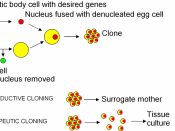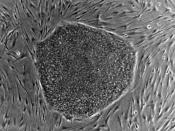Kacee Mossoney
Research Argumentative Synthesis
English 112.10
April 14, 2004
Human Reproductive Cloning Vs. Therapeutic Cloning
Imagine what I could accomplish if there were two or maybe even three of me! I could work full time, go to school full time, and watch my favorite soap opera every day. Wouldn't it be great? I bet my room would even stay clean. Having a clone of me does not sound all too bad. It may get a little confusing for my family and friends, but just think of what I could accomplish.
Okay, this really is not how cloning works. In spite of the myths of human reproductive cloning, it is not a Xerox duplicate of a person. We would not have multiple copies of me, or any other person, walking around, even though that would be nice for my schedule. Cloning only duplicates the genes of the forbearer. The clone would only have the same DNA (National 24).
When someone is cloned, the clone does not become the same person that they were cloned from. They may look like the person, but it is just like being identical twins, that are several years apart in age (Kearns).
Twins are an example of cloning naturally, but there are three different types of human cloning that can occur. One way of cloning is when the human embryo separates in the beginning stages of development. This is how identical twins form. The second type is when human stem cells are used. They have the potential to become a human because of there stem cells. Genes in stem cells, in the beginning stages of embryonic life, have the "encoded knowledge" that allows the cells to form organs and tissue ("Clone"). This type of cloning is used for therapeutic reasons. The cells have to be...


